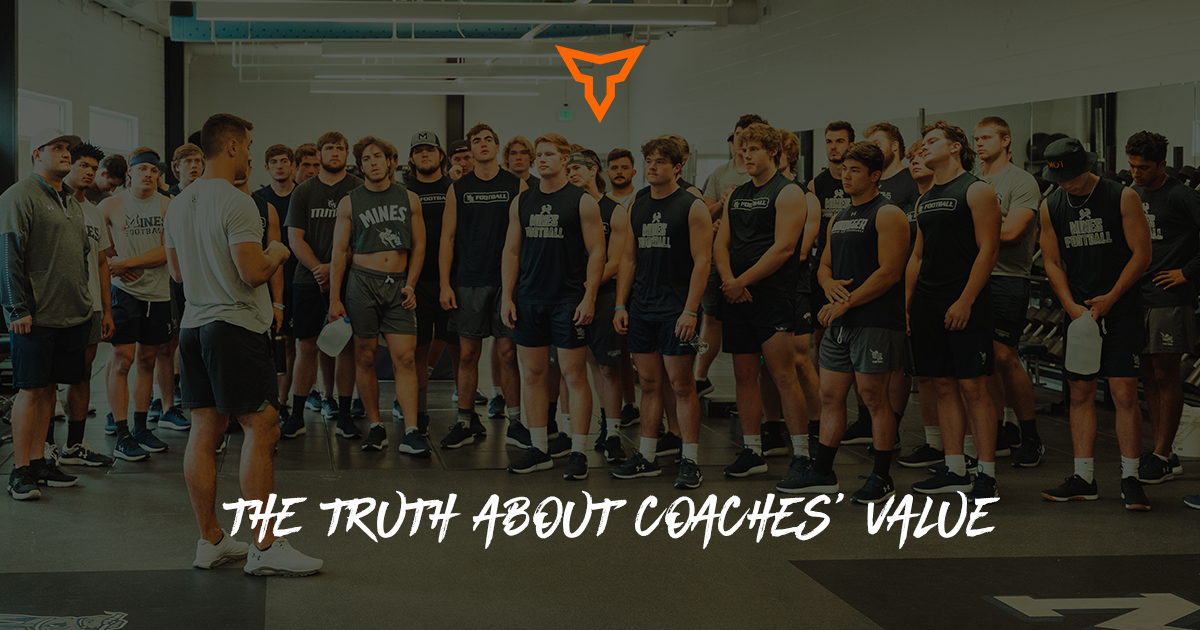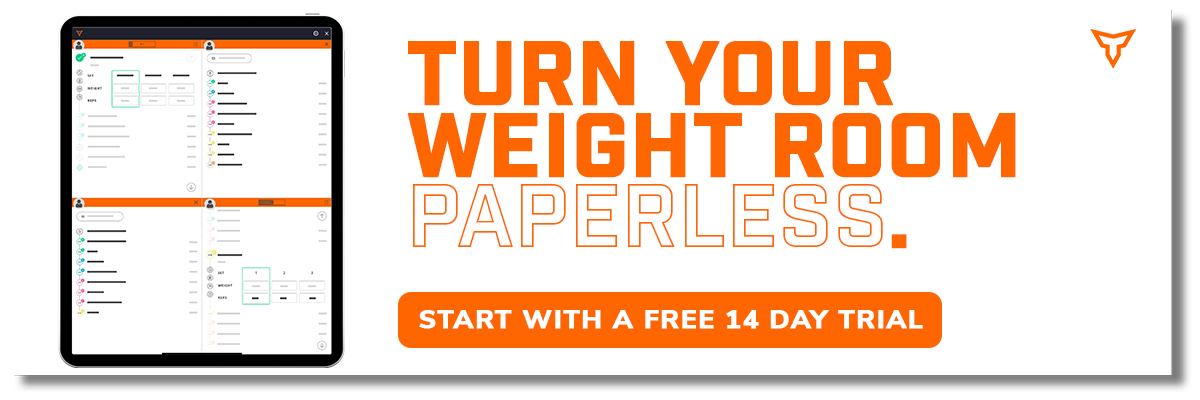8 Lessons From a Young Coach
How many times in the strength and conditioning world do you hear, “Oh Coach X is a football-only strength coach”? While it is important to master your craft within your specific population, it is equally important to see other sides of the field and gain perspective on the human body and its relative performance. As I progressed through my career as a strength and conditioning coach, I’ve had the pleasure of working with many different sides of the field. Below are the major takeaways and lessons learned from each sector I have been in.
Lesson #1: There is no “one size fits all program”.
I had the pleasure of having three college internships locally in the state of Virginia before going to graduate school at the University of Miami and becoming a graduate assistant strength coach in my last 18 months. One thing that stood out to me here is the difference in athletes all across the Division 1 level. There is no “one size fits all” program. Everything is ever-changing and evolving based on what you see as a coach. Our men’s basketball team at my undergrad probably wouldn’t have responded the same way as the men’s basketball team did at Miami to training. I noticed that higher level D1 athletes recovered significantly faster, were more gifted in their sport, and required less stimuli to elicit an adaptation. As we progressed through the macrocycle, everything changed.
When I started on the tactical side, I really struggled with the programming. I had all my methods and programs laid out that would elicit those proper adaptations needed for the men and women that serve our country. However, there was one problem, our program was voluntary and client satisfaction was a major priority. One group that I worked with really loved “Crossfit Style” workouts and did not appreciate the “less is more” approach that our program started in. I did not think that training 3 to 4 qualities at once was a good idea. However, what I had found is that once we started programming a safer version of these workouts, the attendance, satisfaction, metrics and results that our staff was looking for increased. Looking beyond the absolutes was the best thing I ever did in my coaching career because it made me a better coach. In this specific case, the main goal was longevity for this group as opposed to increasing their 3RM deadlift by “X” amount. Instead of being great at a couple of methods, I became great at applying the same principles to every method I have ever used and the new one I have adopted over the time of working as a TSAC.
Lesson #2: In-Season Programming Should be Programmed Week-to-Week Based on What You See
I know a ton of coaches may not like this lesson. As a coach, I am a firm believer that you should always come prepared and program everything out. That being said, you can never fully prepare for what may or may not happen in-season. Personally, I changed my athletes' in-season training program weekly based on what I saw and how long we played. If your teams go into double overtime, do you think they really can work up to 85% of their max in a deadlift or a squat 2-to 3 days after? More than likely not. Remember the goal of the in-season phase is to maintain as much as possible and decrease the likelihood of injury. Account for acute variables such as recovery time between practices, game day stresses, the total accumulation of fatigue, classroom work, test, etc. In this case, less is always more.
To reflect on this lesson, I wanted to touch on the time I was in charge of Men’s Cheer at the University of Miami (FL) as a graduate assistant S&C coach. My programming went off how the athletes felt from the constant travel, 3-hour practices, and overall fatigue from the demands placed on their bodies. In Season, on a good week, I saw these guys 2x per week. More often than not, it was once a week. My main lifts were autoregulated using an RPE scale and accessories changed every 3 weeks so we did not perform the same program 1-2x per week. On top of the main bulk of the workout, we focused heavily on restoration and recovery through education, mobility and flexibility. An example day is below:
Day 1: Miami cheer
Primary Movement:
- A1. Back Squat 4x5 RPE 7-8 (looking at the previous weeks' numbers and RPE)
- A2. Box Jump 3x5 (paired with working sets
- A3. World’s Greatest Stretch
- B1. Decline DB Bench Press 3x6 each
- B2. Bent over SA DB Row 3x8 each
- B3. Prone IYTW’s 3x10 each
- C1. 3-way plank 2x30 sec each
Lesson #3: Be a Positive Role Model
Working at the high school level was easily the most eye-opening experience I have ever had. The specific school I was at was in gang-affected neighborhoods which meant kids experienced very unfortunate circumstances when we left the weight room after school. Due to these circumstances, I had to constantly adjust the way I coached, programmed, and gained the kids' respect as a leader. The first rule of coaching in these environments is very simple but often missed. BE A POSITIVE ROLE MODEL. Hanging around the downtown Richmond Area in a pretty rough hardcore punk rock scene as a kid, and seeing the darker side of the city gave me a good amount of understanding before taking on this role. Most kids had no father figure and actually wanted someone to look up to. By keeping my door open for all students, I learned a lot about what was going on. One time we had girls’ basketball in before the start of their season. They looked sluggish and showed signs of high fatigue while performing a superset that should have been only a 7/10 RPE.
Eventually, safety became an issue and I pulled the team aside. I asked, “Ladies, can someone tell me what the heck is going on"? The team was very good about coming in and working hard so this was unusual. One of the captains spoke up and told me, “Coach T, most of us haven’t eaten in 18 hours or so”. My heart sunk and I stopped the rest of the workout. I discussed the basics of nutrition/practical low-cost solutions with the girls while we stretched. At the end of the day, this is not Westside Barbell and I am not Louie Simmons. We are in a people-first business and numbers should be treated as a secondary result of good programming/coaching.
Lesson #4: Managing Fatigue & Stress
Accumulated stress can destroy a team in the offseason. I was constantly preparing a plan B and C if needed on a given day. An easy example to give context Is below:
Main lift (in an ideal world): Barbell Split squat
Plan B: DB RFE Split Squat
Plan C: BW Split Squat
The need for stress regulation is key to success in the high school setting and helps in long-term athletic development. The kids don’t need to be 500-600 lb lifters. Focus on general preparedness, technique, and overall development (as kids mostly play 2-3 sports a year.)
Lesson #5: Variety is a Must
I had the opportunity to move to Detroit, MI, after my part-time position at the high school couldn’t go full time. I got assigned with the general population groups to start that came in from a major Michigan energy company. I learned really quickly that programming for them was vastly different than the athletic setting. Variety in training was clearly going to be a key to my success. The majority of the general population ranged from 27 years old to 55 years old. No two people were the same in regards to training and tenure, causing me great discomfort as a coach. Long gone were the traditional periodization models that I could rely on, testing protocols became useless, and I had to start from scratch. I now had to appeal more to this population's likes and dislikes by offering a vast amount of variety in training. Every day I would put 2-3 options on the board that were progressed and regressed. Through the variations, I had to approve them before the athlete started.
The same goes for variation in phases. When I first got to work, our strength phase was comprised of three weeks of the same sets, same reps, and no RPE/Gauge of intensity to go with it.
The initial pattern looked like this:
Main Lift: 5,5,3,1,1,1 ….. 1RM
I scrapped this model once I was tasked with changing the strength phase. I changed the reps to the volume prescriptions below:
WK1: Main Lift: 10,8,6,5,5,5 - submaximal strength
WK2: Main Lift: 8,6,5,5,5 – to tech failure at 5RM
Wk3: Main Lift: 6,4,3,3,3 to tech failure at 3RM, single 1RM if the client was advanced
Wk4: Main Lift: 4x5 (55% of whatever your last rep max was)
Lesson #6: Sell Yourself
Selling yourself in strength and conditioning is arguably just as important as being a great programmer. They say you only have one shot at a first impression, so at EXOS in Detroit, I became better and better at nailing down sales, showing value, and understanding how to communicate myself to clients that came in our door. We had a young basketball player who suffered from Osgood-Schlatter disease. I asked him as a player what his previous experience in training was and found out that he had a coach previously who disregarded all aspects of his medical history which inevitably caused him to blow out his knee. Fortunately, he was willing to take a chance on our program and seek out a better way of training. We broke down how posterior chain strength was most likely the cause of all the pain. After developing his hamstrings, glutes, and proper technique, his pain ceased, and his vertical jumping ability improved by 2 inches in just 5 weeks. Needless to say, knee pain was no longer a problem and the trust of the athlete had been earned.
Lesson #7: You Don’t Need Fancy Equipment to Get the Job Done
Some of our population cannot put a bar on their backs, hinge without thoracic compensation, or load the spine at all. This was a big change for me as a coach entering this job at 26 years old. I created medicine ball workouts, kettlebell circuits, landmine routines, etc. This area forced me to get creative about programming.
An example of a day is below:
Circuit #1 – Strength Portion- Landmine RDL 8,8,6,6,5 each
- Reverse Grip Lat Pulldowns 10,10,8,6,6
- Body Saw Abs with towels on floor 10ea, 10ea, 10ea, 10ea, 10ea
- 3-5 Rounds for time
- Farmer Carry x 100 feet
- Sled push x 100 feet
- Rower x 300 meters
- Assault x Bike 10 calories
You will notice that programming has a mixture of strength, work capacity, and overall GPP
Circuit 1 takes 18-25 minutes max for most people and circuit 2 is set at 12-16 minutes of total work/rest. Totaling a great workout for our veterans in less than 40-50 minutes. Notice the plan is also adjustable to help with fatigue & overall tenure as well. There are a million ways to skin the cat in our field, but which one could benefit the operator best given time, tenure, needs, etc.
Lesson #8: Leading an S&C Program
Leading a program has come with its challenges for me. In my role, I have no assistant strength and conditioning coaches so I had to learn fast how to set up structure. I realized I needed help and should have asked for it sooner. The big lesson is ownership. Everything strength and conditioning related falls back onto me. This could be communication breakdown with leadership, having a risk reduction plan in place, equipment purchasing, cleaning, what other people within our program need, etc. You will see every single sub-topic I could dive into has nothing to do with programming or coaching.
Here is a story to help illustrate this lesson. I fell under hard criticism in a previous role I have been in. There was no clear-cut sign of who my supervisor actually was, lofty egos invested in our program, and 5 different individuals wanting 5 different outcomes. I’ll be honest, I was a tad young for the role. By the time I had come up with a plan to satisfy everyone’s needs, it was too late. There were separate meetings held with everyone and no matter what I performed admin-wise, it seemed to upset 1 of the 5 individuals. While the programming and coaching were not bad by any means, everyone was under a different impression of how my role would actually be performed when starting up this program. The big takeaway from this lesson is to get all individuals on the same call or meet in person to establish a plan and to keep everyone on the same page. I highly recommend having everything set in a document to refer back to once established as well. As the head, it is no longer about coaching and numbers. It is about showing leadership and building trust.
Conclusion:
If you look at my career you will see quickly that every role has helped prepare me for the next. You will see the lessons learned only made me a better coach as I’ve progressed through this field. This could be in scientific planning of regression in the high school setting to coming prepared with a plan to present to leadership in the military. I’ve realized as a strength coach that our jobs focus more on people than it does on data, coaching, and programming. Too many times I see coaches get let go and struggle to find a job because they have only worked with one population and bring nothing else to the table. Diversify your resume, show new skills, programming examples, and other points to stand out within the vast pile of resumes for the position that you apply for. You never know when learned skills may come in handy within the next role as a coach both young or old.
Subscribe to our blog
Subscribe to receive the latest blog posts to your inbox every week.
Related posts

Psychology Principles You Should Be Utilizing

The Truth About Coaches' Value


